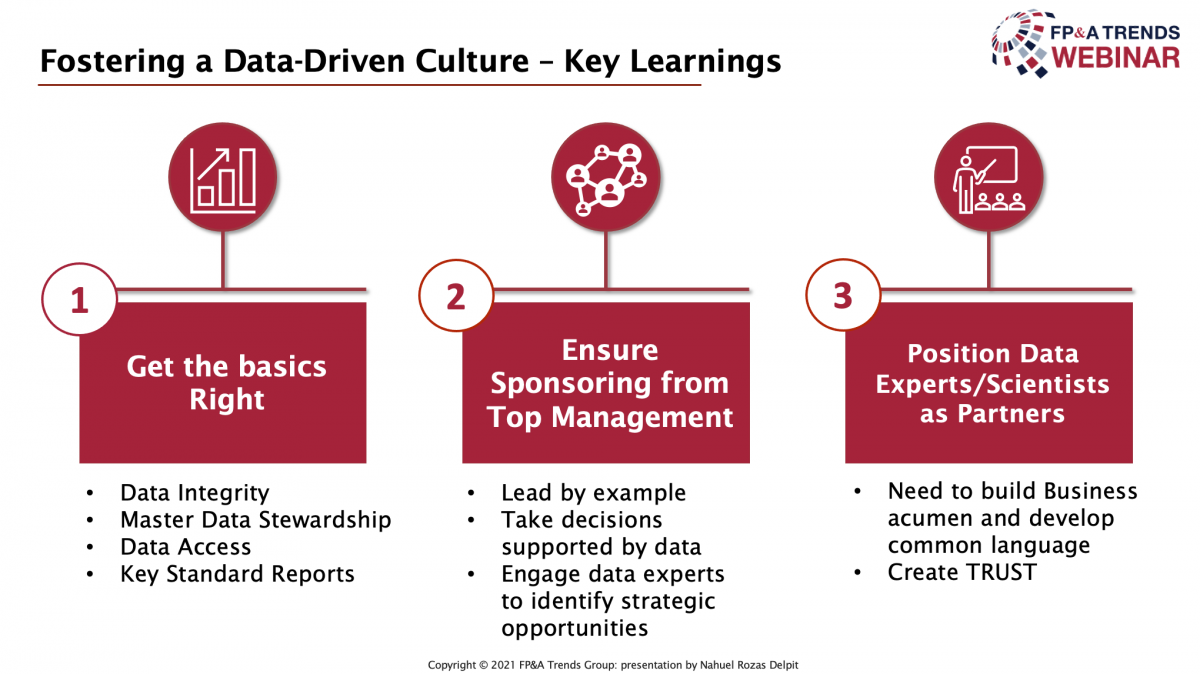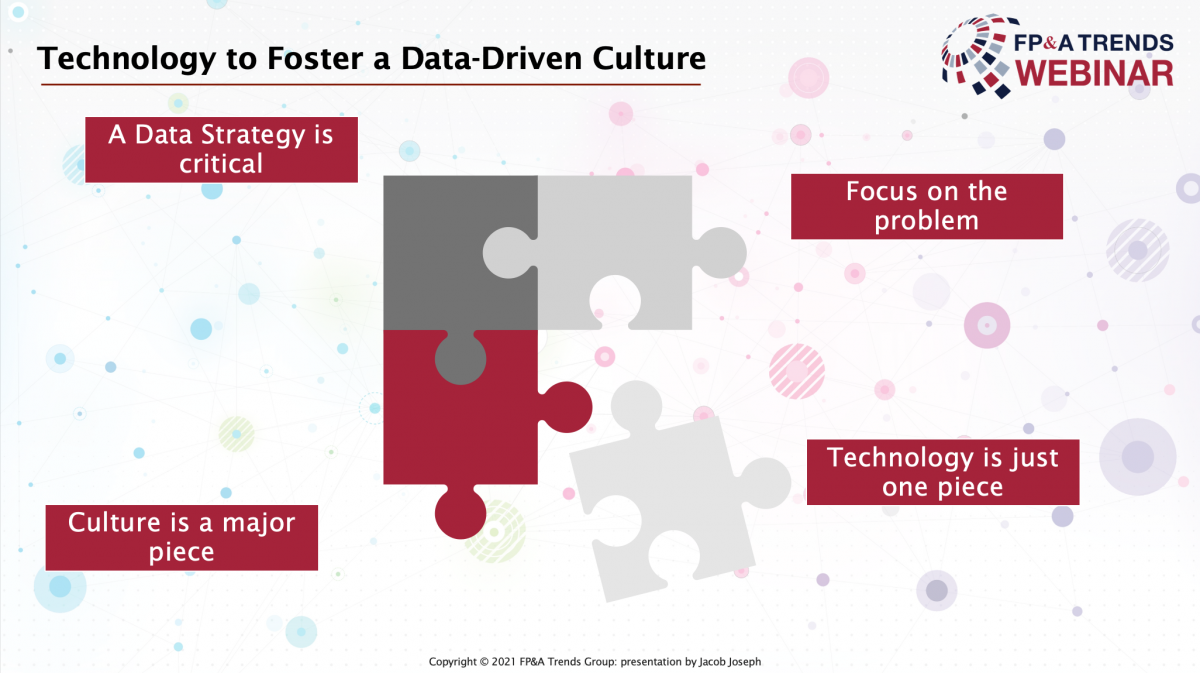When your financial planning and analysis (FP&A) becomes data-driven using automation and an intuitive platform with...
On the 12th of October, I had the pleasure of joining the FP&A Trends Webinar on the Key Steps to Fostering a Data-Driven Culture facilitated by Larysa Melnychuk, Founder and CEO at FP&A Trends Group.
Speakers to the webinar were :
Gary Cokins – Analytics Thought Leader and Author
Nahuel Rozas Delpit – Finance Director, Head of FP&A EMEA, Medtronic
Jacob Joseph – Director, Product & Technology, Prophix Software”.
2021 FP&A Trends Survey Findings regarding the Biggest Issues in FP&A indicated as below that around 60% of problems are related to data (Figure 1):
.png)
Figure 1
However, the reason for the data-related problems within FP&A does not only stem from technology. It is more related to embracing a data-driven culture. To foster a data-driven FP&A culture, 9 pillars have been recognised in modern FP&A:
Sponsorship: Sponsorship of top management to implement a culture embracing the change
FP&A Data Scientist: New type of FP&A professional, who is a bridge between finance and IT
Key Business Drivers: Finding and implementing Key Drivers according to the 20 – 80 principle
FP&A Architect: New type of FP&A professional who scans the data infrastructure of the organisation first and builds collaborative solutions on top
Driver Based Model: Key responsibility of FP&A function for the business
Integrated Planning Platform: Integration of planning with the data structure of the organisation
Access to Key FP&A Data: Making sure that all key stakeholders can reach the FP&A data and insights
Collaborative Scenario Planning: Being ready for different scenarios based on assumptions of the future with the rest of the stakeholders
Storytelling: Being able to explain the story behind the numbers as clear as possible to anyone who needs it
8 Forces for Data-Driven FP&A
Gary Cokins complemented Larysa's pitch with 8 forces that caused interest to data-driven FP&A:
Executives' frustrations with strategy failure: Recent empirical data indicates that CEOs are good with creating strategies but having trouble implementing them. Therefore, they have been involuntarily terminated. They require a partner who will help them to give decisions based on data.
Increased accountability: Today, managers and employees will be monitored and measured based on data. Data makes employees more accountable for their actions.
More rapid decision making: Now, decisions are being made in the near time. Thus, data is helping make these decisions faster.
Mistrust of the managerial accounting system for accuracy: Most managers do not trust managerial accounting systems. An example would be the allocation of overhead expenses are based on square meters or headcounts. A solution to these problems would be Activity-Based Costing (ABC) which produces more accurate results, ultimately backed with data.
Poor customer value management: CFO's should be able to explain not only the sales and margins of each customer but detailed P&L statements per customer applying all available data to increase customer value management. They should be able to direct sales and marketing teams to invest in different types of customers based on the sales results.
Contentious budgeting – poor resource capacity planning: Classic traditional budgeting problems, such as sandbagging or budgets being outdated after a couple of months of starting the new year, etc. are outdated. Also, FP&A solutions are more volume sensitive, therefore an engineer-minded approach is more welcomed for capacity planning.
Dysfunctional supply chain management: Most companies see their suppliers as enemies. However, the relationship between the supplier and the firm should be recognised as a marriage.
Unfulfilled ROI promises from IT systems – lack of integration: ERP implementations are important to be succeded but do they create information or do they create only unusable data?
“If the data is lacking in an organisation, and decisions are being made with only gut feelings, that is the real danger” finalised Gary Cokins in his presentation.
The first polling question was regarding the FP&A forces most resonated for the participants. Results are below (Figure 2):

Figure 2
Learnings From a Practical Case
Nahuel Rozas Delpit, started his presentation with the importance of the “data-driven” organisation culture. A “Data-Driven” culture expresses itself through organisations that take decisions informed by objective data insights to day-to-day operations, management initiatives, strategic plans, etc.
During the pandemic, Medtronic FP&A function has increased the speed of data-driven initiatives to be able to cope with daily-changing scenarios. First, they started with lots of ad-hoc reports and slowly moved to self-predicting forecast solutions, backed with a large scale of data. To do that, they have partnered with a data solutions institute and as an organisation, they have embraced the change and the reality of the black-box aspect of Machine Learning solutions.
Key learnings (Figure 3) while fostering a data-driven culture can be summarised as: Keep it simple!

Figure 3
The Role of Technology in Fostering a Data-Driven Culture
Jacob Joseph, who worked with FP&A teams for a decade as a technology consultant, believes that in today’s world, technology is not the key issue to implement a data-driven culture within an organisation. The first crucial task is to determine the data strategy and focus on the business problem. To be successful though, embracing the changing culture is the most important aspect of all (Figure 4).

Figure 4
The help of technology to unblock the roadblocks during the process is as below:
Eliminate siloed systems with a single source of truth
Visualise your data to identify trends
Automate manual data processing and validation
Apply statistical methods and Machine Learning
Jacob highly suggests starting with a data strategy to implement a successful data-driven culture. Next, data should be touching to key drivers to run the business. If the data is not solving key business issues, then there is no need to start big, instead, small pieces of actions would bring more value. Finally, leveraging cloud technology and making sure all teams within the organisation speak the same language of data will maximise the value of data-driven culture.
Conclusion
Cultural change on FP&A is inevitable. As the world evolves, our cultural norms on business evolve too. The best way is to catch up with the speed of this daily evolving change is through scientific thinking. Now for our profession, data is the lowest meaningful element, such as an atom in a living organism. The advantage will favour the teams who will understand that indisputable fact and, we will witness the process closely in the future.
We would like to thank our global sponsor Prophix for great support with this FP&A Trends Webinar.
Subscribe to
FP&A Trends Digest

We will regularly update you on the latest trends and developments in FP&A. Take the opportunity to have articles written by finance thought leaders delivered directly to your inbox; watch compelling webinars; connect with like-minded professionals; and become a part of our global community.





